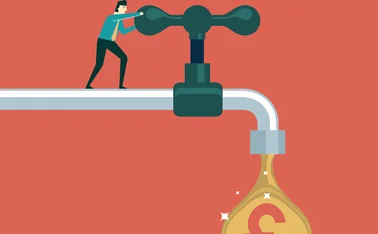
Sustainable infrastructure investment and financing are key to Chinese growth
Infrastructure is key to long-term stability, writes CDB president Zheng

The world economy is still undergoing a period of heavy adjustment, characterised by much instability and uncertainty. Nonetheless, a global consensus has emerged on the significance of infrastructure development, social investment, enhancing economic growth momentum and achieving long-term sustainable development.
China's economy is faced with substantial downward pressure. Annual GDP growth dropped below 7% in the third quarter of 2015, while fixed asset investment growth dropped to 10.3%, its lowest point since 2000. Fixed asset investment has been responsible for approximately half of GDP growth for a long time. The drastic decline in investment growth is having a substantial impact on China's economy. From another point of view, however, China's economic downturn is a manifestation of the longstanding conflicts of its economic transition. This, however, provides an opportunity for structural adjustments and civil welfare improvement.
 Zheng Zhijie
Zheng Zhijie
Infrastructure remains inadequate in rural areas. A great deal of work remains to be done to push forward urban-rural integration and achieve infrastructure connectivity and equity of public services. Even in cities, the capital stock for infrastructure per capita in China only amounts to approximately one third of that in European countries. There is a $10 trillion investment gap to fill before attaining European Union standards. According to an estimate from the Ministry of Housing and Urban-Rural Development, China will be paving 7,000km of underground pipeline in the next three years. With the investment for every kilometer estimated at 120 million yuan, this project alone will bring about one trillion yuan's worth of infrastructure investment.
Diversified and sustainable investment
Infrastructure development is characterised by high levels of investment, long cycles, many uncertainties and relatively low returns, making its implementation a challenge worldwide. Developing countries are especially constrained by funding limitations, while developed countries also face issues such as ageing infrastructure. The key to driving reform and establishing a diversified and sustainable infrastructure investment and financing system lies in exploiting the synergies between government and market action.
Not only can infrastructure development drive investment, but it has the potential to significantly improve the environment for wider economic development. Thus, infrastructure must be prioritised as a government investment target. Rising government debt is a common issue faced by many countries and investment should be made more efficient through capitalising on the government's credit enhancement and leveraging capabilities, in addition to direct funding. This could include setting up funds and offering investment guarantees.
Taking advantage of development finance is also critical. It is market-based, has a slim but guaranteed profit margin, can raise substantial amounts of low cost and medium-to-long-term funds, and can effectively manage the medium-to-long-term risk. Practice has proven that development finance institutions play a decisive role in infrastructure development, no matter if they are multilateral development banks, such as the World Bank and Asian Development Bank, or national-level development banking organisations, such as the China Development Bank (CDB).
The capital stock for infrastructure per capita in China only amounts to approximately one third of that in European countries
Zheng Zhijie, China Development Bank
The participation of cooperative capital is of considerable significance in expanding sources of funds for infrastructure development, reducing the fiscal burden and improving the operating efficiency of infrastructure. Monopolies and all forms of entry barriers should be broken down and relevant statutory rules and investment protection systems should be perfected to create the necessary conditions for cooperative capitals' equal participation. Exploring options to attract medium-to-long-term funds and foreign funds through models such as public-private partnerships or funding; issuing basic infrastructure development bonds to both domestic and international markets; and facilitating the conversion of household savings to the medium-to-long-term development funds, are also important.
CDB's role in infrastructure
The CDB has extensive experience in advancing infrastructure development both home and abroad. Since its establishment in 1994, the CDB has supported the construction of 1.4 million kilometers of highway, 90,000km of railway, 695,000km of power grid, 4,000km of urban rail transit – all of which have contributed extensively to China's economic and social development. Among the CDB's 8.6 trillion yuan-worth of total loans, 4.2 trillion yuan were applied to infrastructure.
The CDB will strive to play a larger part in infrastructure development, both domestically and globally. First, the CDB will commit to stabilising growth, staunchly supporting squatter settlement rebuilding and railway construction, and coordinating with the National Development and Reform Commission's major project packages and increase input into infrastructure development. The CDB will also strengthen innovation in financing models. It will continue to step up inter-industry associations and explore effective models for public products and services provision, including social capital investment into infrastructure. Third, the CDB will fully support the Belt and Road initiative. It will give top priority to the development of high speed rail, road and pipeline networks, nuclear power, and industrial and trade zones.
Only users who have a paid subscription or are part of a corporate subscription are able to print or copy content.
To access these options, along with all other subscription benefits, please contact info@centralbanking.com or view our subscription options here: subscriptions.centralbanking.com/subscribe
You are currently unable to print this content. Please contact info@centralbanking.com to find out more.
You are currently unable to copy this content. Please contact info@centralbanking.com to find out more.
Copyright Infopro Digital Limited. All rights reserved.
As outlined in our terms and conditions, https://www.infopro-digital.com/terms-and-conditions/subscriptions/ (point 2.4), printing is limited to a single copy.
If you would like to purchase additional rights please email info@centralbanking.com test test test
Copyright Infopro Digital Limited. All rights reserved.
You may share this content using our article tools. As outlined in our terms and conditions, https://www.infopro-digital.com/terms-and-conditions/subscriptions/ (clause 2.4), an Authorised User may only make one copy of the materials for their own personal use. You must also comply with the restrictions in clause 2.5.
If you would like to purchase additional rights please email info@centralbanking.com test test test








